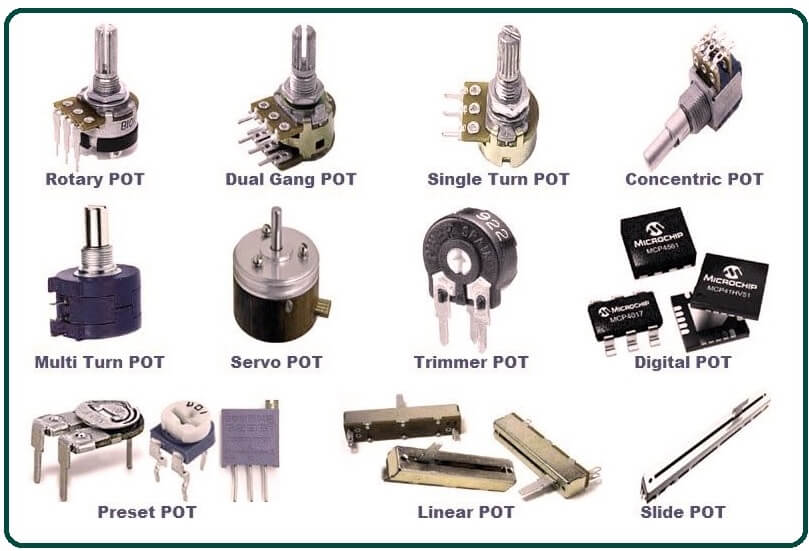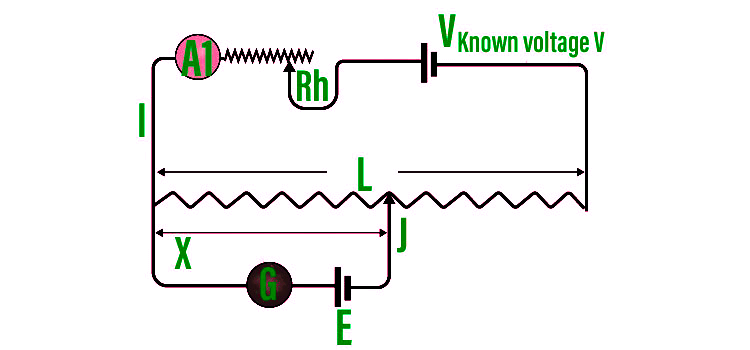
What Is a Potentiometer?

A potentiometer, also known as a POT, is a variable resistor with three terminals. This resistor has an adjustable voltage that you can manually change to control the electric current. This is all controlled with respect to Ohm’s law.
The potentiometer symbol is a rectangle or zigzag line placed between two linear lines. The most well-known potentiometer application is in audio systems for changing the volume or other characteristics of an audio signal.
Potentiometers are manually adjustable variable resistors with three terminals. The two terminals are connected to opposite ends of a resistive element, and the third terminal is connected to a sliding contact, called a wiper, that runs over the resistive element.
The potentiometer essentially acts as a variable resistance divider. The resistive element can be viewed as two resistors in series total potentiometer resistance, where the position of the wiper determines the resistance ratio of the first resistor to the second resistor.
If reference voltages are applied to the end terminals, the position of the wiper determines the output voltage of the potentiometer. A potentiometer is also commonly referred to as a potmeter or pot. The most common form of potmeter is the single-turn rotary potmeter.
This type of pot is often used for audio volume control logarithmic taper as well as in many other applications. Various materials are used to manufacture potentiometers, including carbon composition, cermet, wirewound, conductive plastic, or metal film.
How Does Potentiometer Work?
Potentiometers (or) POT is a passive electronics component consisting of two end terminals with a resistive element and a sliding contact called a wiper that serves as the third terminal.
The input voltage is applied to the two end terminals, and the output is taken between the first end terminal & the sliding contacts. The output voltage will be moved to either of the two input terminals and to the sliding contact. POT helps us to use variable voltage in the same device.
Also known as potmeter or pots, they consist of resistive elements called a track and a sliding contact internally called a wiper where the end terminals are connected to the resistive element.
The resistance is then adjusted with the manual wiper that is running, touching the resistive strip of material. When it is moved closer to terminal 1 and away from terminal 2, the resistance decreases to terminal 1, while the resistance increases to terminal 2 and vice versa.
The input voltages will be applied to the resistor, where the output voltage will be a drop in voltage between the fixed & sliding contacts, as shown below.

They are used to help accurately measure voltage and obtain a variable voltage from a fixed voltage source.
It is a passive device which means they do not require a powers supply or additional circuits to function.
Common examples of potentiometers are:
- Measuring position on gaming joystick
- Controlling audio equipment using the volume controls
Types of Potentiometers:
Currently, there are various potentiometers available in the market. There are manually adjustable potentiometers, & there are also electronically controlled potentiometers. So without further ado, let us jumps right into the first type of potentiometer.
A potentiometer is also commonly referred to as a pot. These potentiometers have three terminal connections.
One terminal is connected to a sliding contact called a wiper, and the other two terminals are connected to fixed resistance tracks. wipers can be moved along the resistive track using either linear sliding controls or a rotary “wiper” contact.
The basic operation of both rotary and linear controls is the same. The most common form of the potentiometers is the single-turn rotary potentiometer. These types of potentiometers are often used in audio volume control logarithmic tapers as well as many other applications.
Various materials are used to make potentiometers, including carbon structures, cermets, conductive plastics, and metal films.
#1. Rotary Potentiometer
These are the most common type of potentiometer, where the wiper moves along a circular path. These potentiometers are mainly used to obtain variable voltage supply across a portion of the circuit.
The best examples of this rotary potentiometer are the volume controller of a radio transistor, where the rotating knob controls the current supply towards the amplifier.
This type of potentiometer includes two terminal contacts where a coherent resistance can be located in a semi-circular model.
And also include a terminal in the middle that is connected to a resistance using a sliding contact connected by means of a rotating knob. The sliding contact can be triggered by turning the knob on the half-circular resistor.
Its voltage can be obtained between two contacts of resistance and sliding. This potentiometer is used wherever level voltage control is required.
#2. Linear Potentiometer
In this type of potentiometer, the wiper moves along a linear path. Also known as a slide pot, slider, or fader. This potentiometer is similar to rotary type, but in this potentiometer, the sliding contact is rotated linearly across the resistor.
The connection of the two terminals of the resistor is connected to the voltage sources. Sliding contacts on the resistor can be moved using paths that are connected through the resistor.
The terminal of the resistor is connected to the sliding one end of the output of the circuit, and the other terminal is connected to the other end of the output of the circuit.
This type of potentiometer is mostly used for calculating the voltage in the circuit. It is used to measure the internal resistance of a battery cell and is also used in mixing systems for sound and music equalizers.
#3. Mechanical Potentiometer
There are different types of potentiometers available in the market, in which mechanical types are used to change the resistance as well as manually control the output of the device. However, a digital potentiometer is used to automatically change its resistance based on the given state.
This type of potentiometer works exactly like a potentiometer, and its resistance can be changed through digital communication like SPI, I2C instead of turning the knob directly.
These potentiometers are called POTs because of their POT-shaped structure. It includes three terminals, namely i/p, o/p, and GND, with a knob on its top. This knob acts as a control to control the resistance by rotating it in two directions, i.e., clockwise otherwise counterclockwise.
Mains drawbacks of digital potentiometers are that they are affected by various environmental factors such as dirt, dust, moisture, etc. To overcome these disadvantages, digital potentiometers (Digi POT) were implemented. These potentiometers can work in environments such as dust, dirt, and moisture without changing their operation.
#4. Digital Potentiometer
Digital Potentiometer, also called Digipot or Variable Resistors, is used to control analog signals using a microcontroller. This type of potentiometer gives an o/p resistance which is variable depending on the digital input.
Sometimes, these are also called RDAC (resistive digital-to-analog converters). This Digipot can be controlled by digital signals rather than a mechanical motion.
Each step of the resistor ladder includes a switch that is connected to the O/P terminal of the digital potentiometer. The ratio of resistance in the potentiometer can be determined through the step chosen at the top of the ladder.
Typically, these phases are indicated with a bit value, e.g. 8-bits is equal to 256 steps. This potentiometer uses digital protocols such as I²C for otherwise SPI bus Serial Peripheral Interface signaling.
Most of these potentiometers use only volatile memory so that once power down, they do not remember their location, and their final location can be stored via the FPGA or microcontroller to which they are connected.
#5. Characteristics
The characteristics of potentiometers include the following.
- It is highly accurate as it works on the evaluation technique rather than the technique of deflection to determine the unknown voltage.
- It sets the equilibrium point otherwise zero, which does not require power to amplitude.
- The potentiometer is working, is free from source resistance because being balanced currently does not flow throughout the potentiometer.
- The salient features of this potentiometer are resolution, taper, marking code, and hop-on/hop-off resistance.
#6. Potentiometer Sensitivity
Potentiometers sensitivity can be defined as the least potential variations that are calculated with the help of a potentiometer. Its sensitivity mainly depends on the potential gradient values (K).
When the potential gradient values are low, the potential differences that a potentiometer can calculate is small, and then the potentiometer sensitivity is high.
So, for a given potential disparity, the potentiometer sensitivity may increase through an increase in the length of the potentiometer. The potentiometer sensitivities can also be increased for the following reasons.
- By increasing the length of the potentiometer
- By reducing the flow of current within the circuit through the rheostat
- Both techniques will help reduce the potential shield value and increase resistivity.
Working Principle of Potentiometer:

Its fundamental working standard depends on whether the potential drop across any piece of wire is perpendiculars to the lengths of the wire if the wire has a uniform cross-sectional area and a constant current flows through it.
“When there is no expected difference between any two hubs, then-current flows.” At present, the potentiometer wire is actually a wire with high resistivity (ρ) with a uniform cross-sectional area A. Accordingly, it has a uniform opposition throughout the wire.
This potentiometer terminal connected to a phone of current high EMF, V (ignoring the opposition inside it) is called the driver cell or voltage source. Assume that the current through the potentiometer is I, and R is the all-around resistance of the potentiometer.
Then from Ohm’s law:
V = IR
We know that
R = ρL/A
Thus,
V = I ρL/A
As ρ & A are always constant & current, I am kept constant by a rheostat.
So
L ρ/A = K (constant)
As a result,
V = KL
Assume that a cell E with less emf than the conductor cell is connected in the circuit as indicated. Let this be EMF, E. The potentiometers have now become E in the potentiometers wire, let’s say at length x.
E = L ρx/A= Kx
When this cell is connected to a suitable length (x) in the circuit shown above, no current will flow through the galvanometer as the potential difference is equal to zero. As a result, the galvanometer G exhibits zero detection.
The lengths (x) is then referred to as the length of the zero point. Now that you have a constant K and length x, you can solve the problem. We will be able to detect the mysterious EMF.
E = L ρx/A=Kx
Second, the EMF of the two cells can be compared assuming that the first cell of EMF, E1, has a zero point on length L1 and the second cell of EMF, E2, has a zero point on length L2.
Then,
E1/E2= L1/L2
Difference Between Potentiometer and Voltmeter:
The main differences between the potentiometer and the voltmeter are discussed in the comparison table.
| Potentiometer | Voltmeter |
| Potentiometer resistances are high and endless. | The resistances of the voltmeter are high & limited. |
| Potentiometer does not draw currents from EMF source | Voltmeters draw littles currents from a source of EMF |
| Potentials inequality can be calculated when it is equal to the fixed potential difference | The potential differences can be measured when it is less than the fixed potential differences |
| its sensitivity is high | It has low sensitivity |
| It only measures EMF; otherwise, the potential difference | It is a flexible tool |
| It depends on the zero deflection techniques | It depends on the deflections techniques |
| It is used to measure the EMF | It is used to measure the terminal voltage of a circuit. |
Rheostat VS Potentiometer:
The main differences between rheostats and potentiometers are discussed in the comparison table.
| Rheostats | Potentiometers |
| It has two terminals | It has three the terminals |
| It has only one twist. | It has single and multi-turn. |
| It is connected in series throughs the loads | It is connected in parallels through the loads |
| It controls currents | It controls the voltage |
| It is only linear | It is linear and logarithmic |
| The materials used to make the rheostats are carbon discs and metal ribbons. | The material used to make potentiometers is graphite. |
| It is used for high-power applications. | It is used for low-power applications. |
Measurement of Voltage by Potentiometer:
The measurement of voltage in a circuit using a potentiometer is a very simple concept. In the circuits, the rheostat must be adjusted, and the current flow through the resistors can be adjusted so that for each unit, the length of the resistors, a precise voltage is dropped.
Now we have to fix one end of the branch to the starting resistor while the other end can be connected to the sliding contact of the resistor using a galvanometer. So, now we have to move the slidings contacts over the resistors until the galvanometer shows zero deflection.
Once the galvanometer reaches its zero states, we have to note the position of the reading on the resistor scale, and based on that; we can find the voltages in the circuit. For betters understanding, we can adjust the voltage for each unit length of the resistor.
Advantages of Potentiometer:
The advantages of a potentiometer include the following.
- There is no chance of error as it uses a zero reflection method.
- Standardization can be done directly using a normal cell.
- Being highly sensitives, it is used to measure small EMF.
- Depending on the requirement, the length of the potentiometer can be increased to achieve accuracy.
- When a potentiometer is used in a circuit for measurement, it does not draw any current.
- It can be used to measure the internal resistance of the cell as well as the EMF is used to compare. Of two cells, but this is not possible with the use of a voltmeter.
The disadvantages of a potentiometer include the following.
- The potentiometer is not convenient to use
- The cross-section area of the potentiometer wire must be consistent, so that is not practically possible.
- When performing an experiment, the wire temperature must be constant, but this is difficult because of the current flow.
- Its main drawbacks are that it requires lots of force to move its wipers or sliding contacts. The movement of the wiper causes erosion. So it reduces the life of the transducer.
- Bandwidth is limited.
Frequently asked questions (FAQs) that you can include in your article about potentiometers:
What is a potentiometer?
A potentiometer, often abbreviated as POT or pot, is a variable resistor with three terminals used to adjust voltage levels in electronic circuits.
How does a potentiometer work?
It works by adjusting the position of a sliding contact (wiper) along a resistive element, changing the resistance ratio between the input terminals and the wiper to control output voltage.
What are the main types of potentiometers?
Potentiometers come in several types, including rotary (circular motion), linear (linear motion), mechanical (manual adjustment), and digital (electronic control).
Where are potentiometers commonly used?
They are widely used in audio equipment for volume control, in instrumentation for precise voltage adjustments, and in various electronic devices where variable resistance is required.
What are the advantages of using a potentiometer?
Potentiometers offer precise voltage control, high sensitivity in measurement applications, and the ability to adjust resistance without requiring external power.
What are the limitations of potentiometers?
Limitations include physical wear over time due to mechanical movement (especially in rotary types), limited bandwidth in high-frequency applications, and sensitivity to environmental factors like dust and moisture in some types.
How do digital potentiometers differ from analog potentiometers?
Digital potentiometers (Digipots) use digital signals for control rather than mechanical adjustment, offering programmability and the ability to store settings electronically.
What factors should be considered when selecting a potentiometer?
Factors such as resistance range, taper (linear or logarithmic), mechanical durability, and environmental resistance (to dust, moisture) are crucial considerations based on the application requirements.
Can potentiometers be used in high-power applications?
While traditional potentiometers are typically used in low-power applications due to their design, high-power variants like rheostats (variable resistors) can handle higher currents.
How are potentiometers calibrated?
Potentiometers can be calibrated using known voltage sources to ensure accurate and consistent output across their range of operation.

